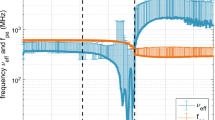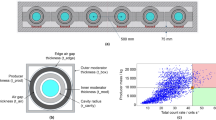Abstract
The capture cell technique is a new approach to the study of extraterrestrial material: although complementary to stratospheric collection techniques1, it avoids selection effects introduced by the deceleration of dust in the Earth's atmosphere. The method, to be used extensively in cosmic dust retrieval experiments on the forthcoming NASA Long Duration Exposure Facility, now yields results from its first application in the microabrasion foil experiment (MFE) which was flown as part of the scientific payload on the STS-3 Space Shuttle mission. Post-flight analysis yielded four hypervelocity impact perforation events during 8 days of exposure to space, and confirmed the capture cell technique as a viable low-cost method for the assessment of the near-Earth participate environment. The effectiveness of a meteoroid bumper2 in dissipating incident particle energy is strikingly demonstrated; markedly different and yet unexplained perforation morphologies are observed and a revision of the current near-Earth microparticle influx model3is suggested.
This is a preview of subscription content, access via your institution
Access options
Subscribe to this journal
Receive 51 print issues and online access
$199.00 per year
only $3.90 per issue
Buy this article
- Purchase on Springer Link
- Instant access to full article PDF
Prices may be subject to local taxes which are calculated during checkout
Similar content being viewed by others
References
Bradley, J. P., Brownlee, D. E. & Veblen, D. R. Nature 301, 473–477 (1983).
Whipple, F. L. in Physics and Medicine of the Upper Atmosphere, 137–170 (University of New Mexico Press, Alberquerque, 1952).
McDonnell, J.A.M. in Cosmic Dust, Ch. 6 (Wiley, New York, 1978).
McDonnell, J. A. M., Carey, W. C. & Dixon, D. G. Lunar planet Sci. 14, 475–476 (1983).
McDonnell, J. A. M. in The Comet Halley Micrometeroid Hazard, 93–97 (ESA SP-153, Noordwijk, (1979).).
Fish, R. H. & Summers, J. L. Proc. 7th. Hypervelocity Impact Symp. VI, 1–26 (Martin, Orlando, (1965).).
Arnaudeau, F., Chau, T. & de Rouvray, A. ESA/ESTEC Report, Contract 4637/81/NL/AB (1981).
Grün, E. & Rauser, P. Space Res. 9, 147 (1969).
Morrison, D. A. & Zinner, E. Proc. 8th lunar Sci. Conf. 841–863 (1977).
Zook, H. A. Proc. 6th lunar Sci. Conf., 1653–1672 (1975).
Huffman, H., Fechtig, H., Grün, E. & Kissel, J. Planet. Space Sci. 23, 215 (1975).
Le Sergeant d'Hendecourt, L. B. & Lamy Ph. L. Icarus 43, 350–372 (1980).
Flavill, R. P., Allison, R. J. & McDonnell, J. A. M. Proc. 9th lunar Sci. Conf., 2539–2556 (1978).
Brownlee, D. E., Hörz, F., Hartung, J. B. & Gault, D. E. Proc. 6th lunar Sci. Conf., 3409–3416 (1975).
McDonnell, J. A. M. & Allison, R. J. Lunar planet. Sci. 12, 682–684 (1981).
Fechtig, H., Grün, E. & Kissel, J. in Cosmic Dust., Ch. 9 (Wiley, New York, 1978).
Clanton, U. S., Zook, H. A. & Schultz, R. A. Proc. 11th lunar Sci. Conf., 2261–2273 (1980).
Author information
Authors and Affiliations
Rights and permissions
About this article
Cite this article
McDonnell, J., Carey, W. & Dixon, D. Cosmic dust collection by the capture cell technique on the Space Shuttle. Nature 309, 237–240 (1984). https://doi.org/10.1038/309237a0
Received:
Accepted:
Issue Date:
DOI: https://doi.org/10.1038/309237a0
This article is cited by
-
Determination of element composition and extraterrestrial material occurrence in moss and lichen samples from King George Island (Antarctica) using reactor neutron activation analysis and SEM microscopy
Environmental Science and Pollution Research (2018)
-
The flux of meteoroids and orbital space debris striking satellites in low Earth orbit
Nature (1986)
Comments
By submitting a comment you agree to abide by our Terms and Community Guidelines. If you find something abusive or that does not comply with our terms or guidelines please flag it as inappropriate.



